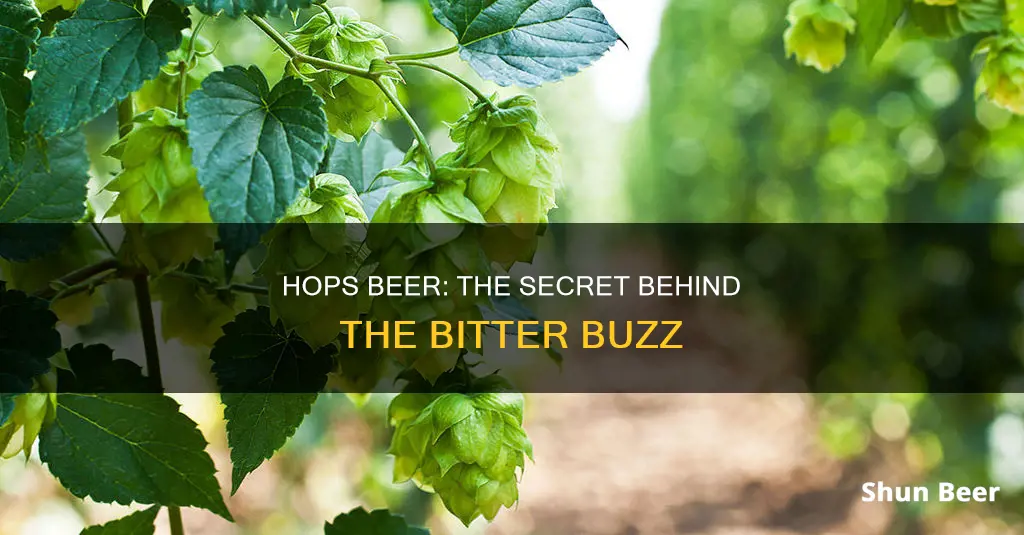
Hops are flowers, or cones, of the Humulus lupulus plant, which is a member of the Cannabaceae family. They are one of the four main ingredients in beer, along with malt, water, and yeast. Hops are primarily used as a bittering, flavouring, and stability agent in beer, adding a hoppy aroma, flavour, and bitterness. They also have antibacterial properties, helping to preserve the beer and prevent spoilage. While hops are now an essential ingredient in beer, they were not widely used until the 9th century, with early brewers using a combination of herbs and flowers known as gruit to achieve a similar effect.
What You'll Learn

Hops are the flowers of the Humulus lupulus plant
Humulus lupulus plants have separate male and female flowers, and only the female plants are used for commercial hop production. The female flowers are round spikes with papery bracts, while the male flowers are panicles. The fruits of the plant are much larger than the flowers, spherical, and straw-coloured.
Hops are most commonly known for their use in beer-making, where they provide bitterness, flavour, and stability to the finished product. They contain alpha and beta acids, as well as various oils, that contribute to the taste and aroma of beer. Hops are added during the boil stage of brewing, as it takes a long time (around an hour) to release the alpha acids that give beer its characteristic bitterness.
In addition to their use in beer, hops can also be used in herbal teas, soft drinks, and herbal medicine. They are also attractive, fast-growing garden plants that can provide privacy and shade in a garden setting.
Where to Find Tropical Hop Beer Near You
You may want to see also

They add bitterness, flavour and act as a preservative
Hops are the flowers, or cones, of the hop plant Humulus lupulus. They are used primarily as a bittering, flavouring, and stability agent in beer.
Hops are added to the boil stage of brewing. This process takes a long time (around an hour) to unleash the "alpha" acids that bitter and balance the sweetness of the malt. Hops contain alpha and beta acids that become part of the brew, and they are responsible for the bitter taste. The degree of bitterness imparted by hops depends on the degree to which alpha acids are isomerized during the boil.
Hops also add flavour to beer. The flavour comes from the unique blend of oils present in each unique variety. Extra hops can be added after the boiling process to flavour the beer without adding bitterness.
Finally, hops act as a preservative. They help to keep beer fresher for longer and protect it from bacterial infections.
The Hoppy Truth: Do All Beers Have Hops?
You may want to see also

There are two main types: bittering and aroma hops
Hops are the flowers of the hop plant, Humulus lupulus, and are used primarily as a bittering, flavouring, and stabilising agent in beer. There are two main types of hops: bittering and aroma hops.
Bittering Hops
Bittering hops are responsible for the majority of the bitter flavour in beer. They have higher concentrations of alpha acids, which are the main source of bitterness in beer. The longer the hops are boiled, the more alpha acids are isomerised, and the more bitter the beer becomes. Bittering hops are typically boiled for 60-90 minutes, and often have inferior aromatic properties, as the aromatic compounds evaporate during the boil.
Aroma Hops
Aroma hops, on the other hand, have a lower concentration of alpha acids and are the primary contributors of hop aroma and flavour. Aroma hops are typically added to the wort later in the process to prevent the evaporation of the essential oils. They are added during the final 30 minutes of the boil to impart "hop taste" or during the final 10 minutes to impart "hop aroma". Aroma hops are also often added after the wort has cooled and while the beer ferments, in a technique known as "dry hopping", which contributes to the hop aroma.
Dual-Purpose Hops
In addition to the two main types of hops, there are also "dual-purpose" hops, which have high amounts of both alpha acids and essential oils. These hops can be added at any stage of the brewing process and are commonly used in Pale Ales and IPAs.
Hops' Role in Brewing: Aromatic and Bitter Beer Balancing
You may want to see also

They are grown all over the world
Hops are grown all over the world, with the United States of America being the world's biggest producer of hops in 2021. The main regions of hops in the US are Washington, Oregon, and Idaho. In fact, Washington state produces over 69% of all hops grown in the US, with the majority of it coming from the Yakima Valley.
Germany is the second-largest producer of hops, with cultivation spread across Hallertau, Elbe-Saale, Tettnang, and Spalt. The Hallertau hop region in Bavaria is only a fairly small portion of land in Germany, but it is the largest and perhaps most famous hop-growing district in the world.
The third-biggest producer of hops is Ethiopia, which produces hops for both domestic use and exporting. The destination market for Ethiopian hops includes Israel, the United States, Canada, and Sweden.
The Czech Republic is the fourth-biggest producer of hops, with the Saaz region producing over 77% of all hops in the country.
China is the biggest producer of hops in the Asia region, with the provinces of Gansu and Xinjiang being the main regions of production.
Other countries that produce meaningful quantities of hops include Poland, Slovenia, Australia, New Zealand, Spain, the United Kingdom, France, South Africa, Canada, Ukraine, and Austria.

Hops are used in the early stages of the brewing process
However, boiling hops for too long can drive off the aromatic oils that give hops their flavour. To balance bitterness and flavour, flavouring hops are added later in the boil, typically with 15 to 30 minutes remaining. This ensures that the unique blend of oils in the hops is preserved, imparting a crisp, hoppy flavour to the beer.
Aroma hops are added last, during the final 5 to 10 minutes of the boil, or even at flame-out when the kettle is removed from the heat. This is because the hop oils responsible for aroma are extremely volatile and will be driven off in the steam if boiled for too long. Adding aroma hops at the end of the boil ensures the maximum amount of aroma is retained.
The addition of hops at different stages of the boil gives the beer complexity and balance. While all beers have at least one hop addition for bitterness, the same hop variety can be used for bittering, flavouring, and aroma.
Frequently asked questions
Hops are the flowers, or cones, of the Humulus lupulus plant. They are used to add bitterness, flavour, and stability to beer.
Hops have a wide variety of aromas and flavour profiles. Some are piney and dank, while others are tropical, citrusy, spicy, or floral.
Bittering hops have higher concentrations of alpha acids, making them more economical for bittering beer. Aroma hops tend to have more essential oils that contribute to the "hoppiness" of a beer.
Some popular varieties of hops include Citra, Cascade, Mosaic, Amarillo, Magnum, Centennial, Chinook, Simcoe, and Nelson Sauvin.
Hops are usually added during the boil stage of brewing, as it takes a long time (around an hour) to unleash the alpha acids that bitter and balance the sweetness of the malt. Hops can also be added later in the process, during fermentation (dry hopping), or even fresh (wet hopping).







